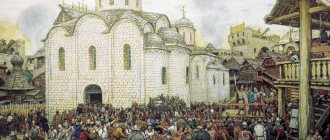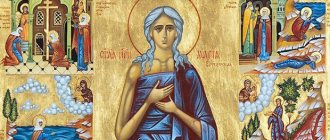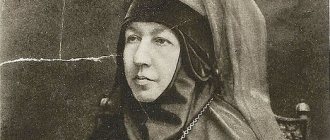| Saint Sophia (Solomonia) of Suzdal |
Sophia of Suzdal
(c. 1490-1542), Grand Duchess, Venerable Commemorated on August 1 on the day of the discovery of the relics, on December 16 and in the Cathedral of Vladimir Saints
In the world, Sverchkova-Saburova Solomonia Yuryevna, daughter of the boyar Yuri Konstantinovich Sverchkov-Saburov, is from an old, but “seedy” Moscow boyar family [1]. She lost her mother early and was raised by her aunt, Evdokia Ivanovna (father’s sister). She was distinguished by her kindness and piety.
Marriage
In 1505, she was chosen as the heir to the throne, the future Grand Duke Vasily III Ioannovich. She was chosen from 1,500 maidens presented to the court for this purpose from all over the country, following the model of the bride parade for the Byzantine emperors. The wedding took place on September 4 of the same year, after the betrothal of the newlyweds by Metropolitan Simon in the Assumption Cathedral of the Moscow Kremlin.
They lived, according to the chronicles, in complete harmony. But the twenty-year marriage was not happy, since Solomonia turned out to be barren. In order to have an heir, the Grand Duke decided to divorce her. Metropolitan Varlaam, Prince-monk Vassian (Patrikeev), and Rev. Maxim the Greek stood up against, and were exiled, and the Metropolitan was defrocked for the first time in Russian history. The next metropolitan, Daniel, approved the divorce, and the boyars joined him. But there were also those who opposed it, like Prince S. Kurbsky. All the eastern patriarchs condemned the act of the Grand Duke, and the Patriarch of Jerusalem, according to legend, predicted the birth from a second marriage of a baby who would amaze the world with his cruelty - Tsar Ivan the Terrible [2].
tonsure
In November 1525, the divorce was announced and on November 25, Vasily ordered Solomonia to be tonsured into monasticism. She was tonsured under the name of Sophia at the Nativity Convent. Some chronicles say that the divorce and tonsure took place at the request of Solomonia herself, but the German ambassador S. Herberstein, on the contrary, writes that Solomonia tore off her monastic doll and trampled it under her feet, for which the boyar Shigonya-Podzhogin hit her with a whip. Many boyars and churchmen sympathized with Solomonia, and boyar Bersen-Beklemishev even tried to come to her defense, but Vasily furiously exclaimed: “Go away, you scum, I don’t need you!” Prince Andrei Kurbsky subsequently wrote about forced tonsure. Another version says that the tonsure was performed by the abbot of the St. Nicholas Monastery, David. As Solomonia resisted with all her might, the boyar who was present struck her, crying out: “Do you dare resist the will of the sovereign?” [3]
Less than two months later, Vasily Ioannovich married Elena Glinskaya. In the meantime, nun Sophia was taken to the Suzdal Intercession Monastery, which she had patronized since 1518. Subsequently, the monastery became a place of imprisonment for involuntary royal tonsures.
Rumors about a son
According to some information, including Herberstein's story, a few months later there were rumors that the accusation of infertility was unfair, that Solomonia gave birth to a son in the monastery - Tsarevich George. The spreaders of rumors were punished, clerks were hastily sent to Suzdal to clarify the matter, but Solomonia refused to show them the child, declaring that they “are not worthy for their eyes to see the prince, and when he puts on his greatness, he will take revenge for the mother’s insult.” Then boyars and clergy were sent, but no documents were preserved about the results of this investigation. It is only known that Solomonia announced the death of her son, and the grand ducal ambassadors were shown the tomb.
Archaeologist and historian Count S.D. Sheremetyev believed that Solomonia hid her son with reliable people. This version is confirmed by the discovery of a small nameless tomb in the basement of the Intercession Cathedral of the Suzdal Intercession Monastery by Suzdal researcher A.D. Varganov in 1934, located between the tombs of a certain “Elder Alexandra” (+ 1525) and the venerable “Elder Sophia”. In the tomb, only a rag doll was found, dressed in baby vests embroidered with pearls. Restored, this shirt is in the historical exhibition of the Suzdal museum, next to it is the lid from that tomb. The name of George was popularly associated with the legendary robber Kudeyar, who, according to one legend, was a bandit in the forests between Suzdal and Shuya. Tsar Ivan the Terrible was also very interested in the story of George [4].
Monastic feat
| Venerable Sophia of Suzdal. 17th century icon. Pokrovsky Monastery |
Living in the Suzdal monastery, the Grand Duchess did not immediately reconcile herself with her new position and grieved for a long time. But submitting to the will of God, Sophia found consolation and peace in fervent prayer. With her deeds, she expelled worldly thoughts from her heart and completely devoted herself to God. After the death of Vasily III in 1533, power passed to his widow, Elena Glinskaya, for whom Sofia could become a most dangerous rival. Therefore, the saint was exiled to Kargopol, where she was kept in prison until Glinskaya’s death in 1538. Then she returned to Suzdal, where she reposed in God on December 18, 1542. The degree book says about this: “Having lived gratefully and pleasingly to God, he departed.” St. Sophia was buried according to her will, in the basement of the Intercession Cathedral of the Suzdal Intercession Monastery.
Reverence
The rumor about the nun's holiness quickly spread throughout Rus' and the saint was already recognized as a saint by her contemporaries. Prince Andrei Kurbsky, in a letter to Ivan the Terrible, calls the blessed princess “venerable martyr.” Ivan the Terrible himself allegedly placed a shroud woven by his wife Anastasia on her tomb [5]. Both his sons and their wives, and Mikhail Fedorovich, the first tsar from the Romanov dynasty, and many others came to the relics of St. Sophia. Tsarina Irina Feodorovna sent to Suzdal “a velvet cover with the image of the Savior and saints to the Grand Duchess Solomonida, and to the monastery Sofia.”
In his description of the city of Suzdal, the sacristan Anania reported miraculous healings at the tomb of St. Sophia. So, in 1598, at her tomb, Princess Anna Nechteva, who had suffered from blindness for six years, regained her sight. In 1609, during the invasion of the Poles, the Monk Sophia saved Suzdal from ruin, appearing in a menacing form to the leader of the military detachment of the Poles, Lisovsky. His arm was paralyzed from fear, and he swore an oath to leave the city and the monastery alone. Many other miracles happened through the prayers of St. Sophia.
Patriarch Joseph wrote to Archbishop Serapion of Suzdal about singing dirges and prayers over Sophia, and in 1650 he allowed her to be venerated as a saint.
In handwritten calendars she is referred to as “The Holy Righteous Princess Sophia, a nun, who was a virgin in the Intercession Monastery, a wonderworker.” On the icons the venerable woman began to write: “Aki Evdokia”: schema-green, mantle-hook, in both hands a scroll, underside-sankir, and sometimes she writes: the mantle is quilted at the gate, tied in a knot at the hem, the hand is visible under the mantle, the right prayer service, and in the left scroll.
The icon of the saint, painted back in the 17th century, has survived to this day and is miraculous.
In the middle of the 18th century, the question of her canonization arose. Later, in the 19th century, Archbishop Serapion of Suzdal and Tarusa [6] compiled a service for the saint. Finally, with the blessing of the Holy Synod, her name was included in the Orthodox Church Calendar of 1916. Since 1984, by a special decree of Patriarch Pimen, the Russian Orthodox Church began to venerate St. Sophia among the host of locally revered saints of the Vladimir-Suzdal land.
The saint’s grave was very revered, but her relics were not disturbed until the 1990s, when, on August 14, 1995, the saint’s relics were solemnly discovered. They were dug up and transferred from the monastery tomb to the Intercession Cathedral. The relics in the opened tomb turned out to be incorruptible, but after the opening they immediately decayed, i.e. crumbled. Now they are stored in a closed container and are not displayed.
Saint Sophia of Suzdal
Hello, dear visitors of the Orthodox website “Family and Faith”!
In the world, the Venerable Sophia was Grand Duchess Solomonia Saburova. She was the first wife of the Grand Duke of Moscow Vasily Ioannovich, who chose her as his wife from among the five hundred most beautiful girls.
But, unfortunately, the grand ducal couple never had children, which they greatly mourned. They were married for twenty years. After which the Grand Duke decided to enter into a second marriage with the Lithuanian princess Elena Glinskaya.
Metropolitan Varlaam exposed the illegality of the dissolution of Vasily Ioannovich’s marriage with Solomonia. For which, for the first time in Russian history, he was removed from the metropolitan throne and imprisoned in a monastery. The Monk Maxim the Greek also stood up for Princess Solomonia and was banned.
Grand Duchess Solomonia was forcibly tonsured with the name Sophia in the Moscow Nativity Monastery. After her tonsure, she was sent under guard to the Suzdal Intercession Monastery, which subsequently became a place of imprisonment for involuntary royal tonsures.
The Grand Duchess did not immediately come to terms with her new position and grieved for a long time. But then she submitted to the will of God and began to pray fervently, which brought joyful consolation into her heart.
Times of the life of St. Sophia of Suzdal
The time of her life falls on the period of Russian history, when the gathering of Russian lands took place.
Grand Duchess Solomonia became the first to be chosen by the Russian prince from among the Russians. Previously, the tradition was strictly observed that the wife of the Grand Duke should correspond to his status. Ivan III's wife was Sophia Paleologus, a Byzantine princess. And she is already looking for a wife for her son according to the Byzantine model. There is a strict selection of girls from a large number. One such girl of fifteen years of age was Solomonia. She eventually becomes the wife of Vasily III. She was distinguished not only by her beauty, but also by her very modest disposition.
The time during which these events occurred was quite difficult.
Vasily III's father, Ivan III, tried in every possible way to collect and create Russian lands. The same task faced Vasily III. In the year of his wedding, he just becomes the ruler of Rus'. There were a lot of problematic political issues. The city of Pskov did not want to join Moscow. And other territories that should have been annexed either by force or diplomacy to Moscow.
How did Grand Duchess Solomonia end up in the monastery?
Princess Solomonia, having arrived at the grand ducal court at the age of fifteen, began to be active. The townspeople and the courtyard loved her very much. She does charity work. Family relations were good.
But a tragedy occurs, which was laid down by the previous period. Vasily and Solomonia had no children, therefore, no heir to the throne, which put the government at risk. Vasily III had constant competitors for the throne. And here he faced a global choice. Family relationships with a spouse or the birth of an heir, politics. If power had left the hands of Vasily III, then conflicts and struggles for the throne would have begun again, which would have had a negative impact on Rus'.
The birth of the future heir to the throne
In those days, Orthodox people could not imagine the possibility of destroying a church marriage. The highest church hierarchy, of course, did not support the dissolution of the marriage of Basil III and Solomonia. But Vasily III decided to enter into a second marriage. And Solomonia was imprisoned in a monastery and took monastic vows.
From the second marriage of Vasily III and Elena Glinskaya, the future heir to the throne, Ivan the Terrible, was born, after whose son, Fyodor Ioannovich, the Rurik dynasty ended.
Saint Sophia of Suzdal
The life of nun Sophia in the monastery was no different from the life of other nuns. She did not shy away from any work.
Although she took monastic vows in Moscow, she very quickly ended up in the Suzdal monastery, where she spent her entire life. And Sophia died already during the reign of Ivan the Terrible, the son of Vasily III from his second marriage.
After the death of nun Sophia, miracles began to occur at her tomb. People began to come there, and popular veneration of the princess began. They respected the princess even during her lifetime as a person, as a nun.
After death at the tomb of Sophia, healing from blindness occurred. Popular rumor spread this over a long distance. And pilgrims began to flock to the Suzdal monastery. There is a legend that Ivan the Terrible himself was there. Fyodor Ioannovich and his wife visited and bowed to this grave. Irina Godunova even made a special cover that was used to cover the relics.
There is a legend in the Suzdal monastery that Saint Sophia dug a well herself. What strength, endurance and humility were needed for this! Once in the monastery courtyard, she does not shy away from any work. She resigned herself to the fate that befell her, cut off her will and surrendered her life into the hands of God.
Nun Sofia saved Suzdal from Polish invaders
The Suzdal Intercession Monastery was not equipped for defense. It had fairly low walls. It was obvious that the invaders could easily take the Intercession Monastery.
But a miracle happens. Nun Sophia, who had died at that time, comes to the commander of the Polish troops with a stern admonition. She burns his hand with a candle and strictly orders him not to touch the Intercession Monastery. The hand actually goes numb. Great fear fell on the invaders, and Suzdal was free.
Memory of Venerable Sophia of Suzdal
It is known that in a letter to Tsar Ivan the Terrible, Prince Kurbsky called the princess-nun a “venerable martyr.”
St. Sophia died in 1542 and was buried in the Suzdal Intercession Monastery.
Under Tsar Theodore Ioannovich, the son of the Terrible, she was already revered as a saint. In the 19th century, Archbishop Serapion of Suzdal and Tarusa compiled a service for the saint.
There are known cases of healing at the saint’s tomb, as well as her appearance during the Time of Troubles.
Troparion, tone 4
Clearly adorned with the beauty of the Most High, the Venerable Sophia labored through fasting labors, and became the heir to the Heavenly Kingdom, and entered into the Heavenly Palace to enjoy the beauty of Christ, pray to him to save the city of Suzdal from the filthy presence and civil strife and grant our souls great mercy.
Kontakion, tone 1
Having escaped the nights of passion, the God-wise Venerable Sophia, having come to the Invincible Slain, Christ, put to death this carnal wisdom by fasting, abstinence and prayers, appearing equal to an Angel, for on earth you drove away unclean spirits from people, and gave various healings, Deliver us from many troubles and evils, O Reverend Sophia, pray for our souls to be saved.
Spiritual reading for December 29
Grand Duke's divorce
Contrary to popular belief, it was not Henry the Eighth who began the tradition of royal divorces.
In 1525, after twenty years of childless marriage, Vasily the Third decided to divorce his wife. Evil tongues claimed that it could not have happened without the “charms” of the young princess Elena Glinskaya, with whom Vasily married without waiting even a year.
The divorce of Vasily the Third was the first and unprecedented in the history of Rus'. The prince’s decision was supported by the boyars, but was harshly condemned by the clergy, many of whom paid with their freedom for protecting the princess.
Nevertheless, the decision was made. The prince acted “of his own free will” and after the divorce, Princess Solomonia had to take monastic vows and retire to a monastery.
Princely share
Alas, her further fate was tragic. Throughout the twenty years of marriage, the princess remained childless. Neither fervent prayers, nor trips to holy places, nor long services in churches helped. The Grand Duke's displeasure grew, the situation around the unfortunate Solomonia became increasingly tense. Passionately wanting to have an heir, Vasily the Third forbade his brothers to marry, fearing that the grand-ducal throne would go to his nephews. All this saddened the smart and kind princess, but she could not do anything.
What Princess Solomonia looked like
Not a single lifetime portrait of Princess Solomonia Saburova has survived to this day. We do not know whether such images existed at all, since portraiture, like secular art, came to Russia only in the Peter the Great era, almost two centuries after the events described. Several miniatures from chronicles depicting scenes of the wedding of Vasily the Third and Solomonia, the tonsure of the princess and several other significant historical episodes from the life of the princely couple have been preserved. Contemporaries described Solomonia Saburova as a woman of extraordinary beauty.
A 19th-century engraving depicts a young dark-haired woman with regular features wearing a tiara and expensive clothes. It is difficult to say whether the real Solomonia was similar to the portrait image created by the artist of the Romantic era. Her image in monasticism is known, but, most likely, it was also written after the death of St. Solomonia-Sophia.
What do they bring to the saint?
They turn to St. Sophia with various requests and pleas. Already in our time, the list of miracles revealed by her is replenished with new evidence. People mainly turn to her with requests for relief from all kinds of diseases. First of all, Sofia of Suzdal is revered among the people as a healer. What else does the saint help with? As we remember, during her lifetime Princess Solomonia was barren. However, an amazing fact is that prayer to Saint Sophia helps infertile couples find a long-awaited child.
There is evidence that she showed the way to the lost, protected children from harm, and helped soften the grumpy nature of the elderly.








